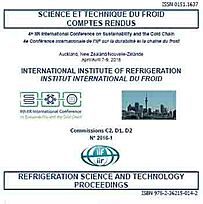
IIR document
Demand response in refrigerated warehouses and thermal energy storage.
Author(s) : LEDUCQ D., VENDE P. E., HOANG H. M.
Summary
50% of the energy consumed in food cold chain is for chilling, freezing and storage steps. For cold storage facilities, refrigeration is the main source of energy consumption with an average of 50 kWh/m3/year. A possible strategy to reduce their energy consumption is to take advantage of the variation of performance of the refrigeration systems during a day due to external and internal temperature variations. Electricity cost can also widely change during a day, depending on the local production. This strategy can be based on additional storage capacities to delay the refrigeration running period, but also on the use of the thermal inertia provided by the storage warehouse itself and the products stored. Using coupled models of the building, products and refrigeration system, potential energy savings of additional thermal storage units in a frozen products warehouse are evaluated.
Available documents
Format PDF
Pages: 8
Available
Public price
20 €
Member price*
Free
* Best rate depending on membership category (see the detailed benefits of individual and corporate memberships).
Details
- Original title: Demand response in refrigerated warehouses and thermal energy storage.
- Record ID : 30017559
- Languages: English
- Source: 4th IIR International Conference on Sustainability and the Cold Chain. Proceedings: Auckland, New Zealand, April 7-9, 2016.
- Publication date: 2016/04/07
- DOI: http://dx.doi.org/10.18462/iir.iccc.2016.0038
Links
See other articles from the proceedings (63)
See the conference proceedings
-
Sustainability enhancement of refrigerated ware...
- Author(s) : FIKIIN K., SLUIS S. van der, PARASKOVA P., et al.
- Date : 2010/09/01
- Languages : English
- Source: 9th Conference on Phase-Change Materials and Slurries for Refrigeration and Air Conditioning. Proceedings: Sofia, Bulgaria, September 29-October 1, 2010.
- Formats : PDF
View record
-
Preparation and properties of lauric acid-decan...
- Author(s) : XU W., ZHANG X., LIU T., et al.
- Date : 2015/08/16
- Languages : English
- Source: Proceedings of the 24th IIR International Congress of Refrigeration: Yokohama, Japan, August 16-22, 2015.
- Formats : PDF
View record
-
Thermal energy storage for sustainable future: ...
- Author(s) : CHIU J. N. W., MARTIN V.
- Date : 2010/06/13
- Languages : English
- Source: IIR/Eurotherm sustainable refrigeration and heat pump technology conference. Proceedings of the Eurotherm Seminar No. 88, Stockholm, Sweden, June 13-16, 2010.
- Formats : PDF
View record
-
Experimental investigation of heat transfer tub...
- Author(s) : TAY N. H. S., BRUNO F., BELUSKO M.
- Date : 2010/04/12
- Languages : English
- Source: 9th IIR-Gustav Lorentzen Conference on Natural Working Fluids (GL2010). Proceedings. Sydney, Australia, April 12-14, 2010.
- Formats : PDF
View record
-
Experimental analysis of isothermal behavior of...
- Author(s) : OLIMAT A. N., SALAYMEH A. al-, MAAITAH A. al-, et al.
- Date : 2015/03/08
- Languages : English
- Source: 5th Jordanian IIR International Conference on Refrigeration and Air Conditioning. Proceedings: Aqaba, Jordan, March 8-10, 2015.
- Formats : PDF
View record
